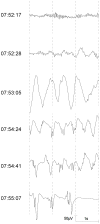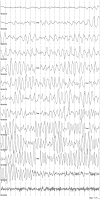Incidence of epileptiform EEG activity in children during mask induction of anaesthesia with brief administration of 8% sevoflurane
- PMID: 22829896
- PMCID: PMC3400655
- DOI: 10.1371/journal.pone.0040903
Incidence of epileptiform EEG activity in children during mask induction of anaesthesia with brief administration of 8% sevoflurane
Abstract
Background: A high incidence of epileptiform activity in the electroencephalogram (EEG) was reported in children undergoing mask induction of anaesthesia with administration of high doses of sevoflurane for 5 minutes and longer. This study was performed to investigate whether reducing the time of exposure to a high inhaled sevoflurane concentration would affect the incidence of epileptiform EEG activity. It was hypothesized that no epileptiform activity would occur, when the inhaled sevoflurane concentration would be reduced from 8% to 4% immediately after the loss of consciousness.
Methodology/principal findings: 70 children (age 7-96 months, ASA I-II, premedication with midazolam) were anaesthetized with 8% sevoflurane in 100% oxygen via face mask. Immediately after loss of consciousness, the sevoflurane concentration was reduced to 4%. EEGs were recorded continuously and were later analyzed visually with regard to epileptiform EEG patterns. Sevoflurane at a concentration of 8% was given for 1.2 ± 0.4 min (mean ± SD). In 14 children (20%) epileptiform EEG patterns without motor manifestations were observed (delta with spikes (DSP), rhythmic polyspikes (PSR), epileptiform discharges (PED) in 10, 10, 4 children (14%, 14%, 6%)). 38 children (54%) had slow, rhythmic delta waves with high amplitudes (DS) appearing on average before DSP.
Conclusions/significance: The hypothesis that no epileptiform potentials would occur during induction of anaesthesia with a reduction of the inspired sevoflurane concentration from 8% to 4% directly after LOC was not proved. Even if 8% sevoflurane is administered only briefly for induction of anaesthesia, epileptiform EEG activity may be observed in children despite premedication with midazolam.
Conflict of interest statement
Figures



References
-
- Jöhr M, Berger TM. Paediatric anaesthesia and inhalation agents. Best Pract Res Clin Anaesth. 2005;19:501–522. - PubMed
-
- Dubois MC, Piat V, Constant I, Lamblin O, Murat I, et al. Comparison of three techniques for induction of anaesthesia with sevoflurane in children. Paediatr Anaesth. 1999;9:19–23. - PubMed
-
- Baum VS, Yemen TA, Baum LD. Immediate 8% Sevoflurane induction in children: A comparison with incremental sevoflurane and incremental halothane. Anesth Analg. 1997;85:313–316. - PubMed
-
- Adachi M, Ikemoto Y, Kubo K, Takuma C. Seizure-like movements during induction of anaesthesia with sevoflurane. Br J Anaesth. 1992;68:214–215. - PubMed
-
- Haga S, Shima T, Momose K, Andoh K, Hashimoto Y. Anesthetic induction of children with high concentrations of sevoflurane. Masui. 1992;41:1951–1955. - PubMed
Publication types
MeSH terms
Substances
LinkOut - more resources
Full Text Sources
Other Literature Sources
Medical
Miscellaneous

